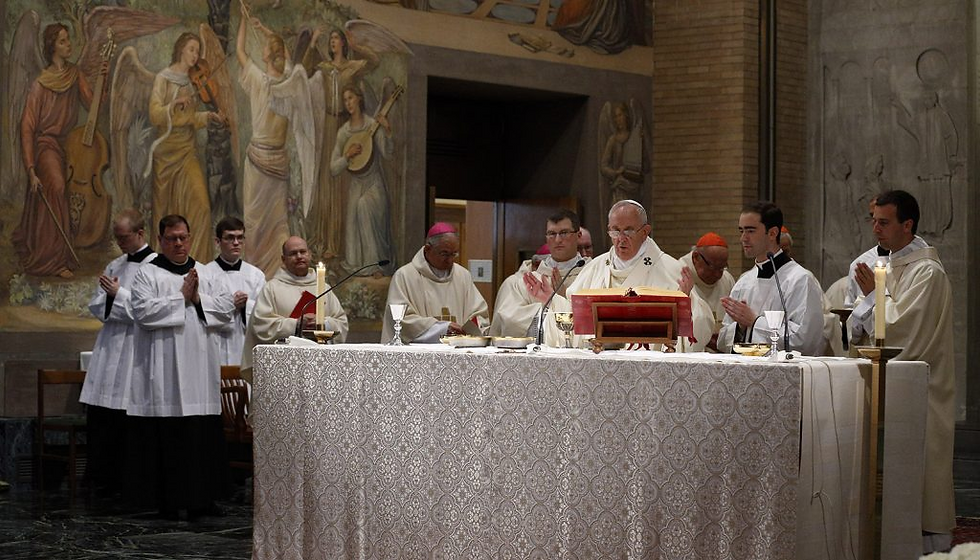The Trindentine Mass in the Post Vatican II Church
- Lily Potito
- Sep 5, 2021
- 4 min read
Updated: Apr 14, 2024

Pope Francis celebrates Mass at the Pontifical North American College in Rome in 2015. (CNS/Paul Haring)
I recently reposted an article, "A Jesuit pope defies do-nothing expectations on the liturgy" on my Facebook page. (Here's a link: https://angelusnews.com/voices/a-jesuit-pope-defies-do-nothing-expectations-on-the-liturgy/?fbclid=IwAR1kRGkZfstsNVmyL2o9OODSgIA51qd3sNgGn3L8cmQO_cdKVrJAHgwchzQ). My sister Mary asked "What is your opinion, if you’re willing to share? I don’t understand outlawing the Tridentine mass, which some people prefer, while encouraging local translations of liturgical texts, which seems like a whole new can of (Diet of?) Worms."
This is a complicated question and issue. My response here is my personal opinion; I do not claim to speak for the Catholic church, or for other proponents on either side of the issue.
Suppose you are named the Director of a clinical program with a variety of sites, and a diverse population served. These programs all need to use various centralized forms and protocols to deliver the programs offered. Some fifty years ago, all of those forms and protocols were updated and revised to use the common language of the people served in each particular area, so that the people could understand the programs being offered.
However, when you begin to review reports, you find that in some areas, both the new and old forms and protocols are being used. You research the issue, and find that when the changes were first made, some people were very resistant to change. They continued to use the old formats, because they thought they were better, and more respected by the people. As time went on, these people continued to use the old formats, and introduced them to younger people, and convinced the younger people that the old formats were better. You come to realize that a series of low-level clerks have systematically undercut the authority of the Director to define the program. You see that many of the people who claim loyalty to the old formats have limited exposure to the new format. Not only that, but they don’t understand the old format, because the language used in the old format is foreign to them. While they can translate the forms, they can’t speak or think in the foreign language, so their understanding can never deepen from a superficial one. And the reason they have limited exposure to the new format is simply that they refuse to experience it, because of the prejudice they have been taught.
As the new Director, you have sympathy for the people who grew up with the old format, and you know that when the format was first changed, the old continued to be used in large part for the benefit of those who were older, and uncomfortable with changing that which they had always known. But you realize that the fact that the old format is still being widely used has caused division in the corporation and has hurt the unity of the message. You take steps to rein in the use of the old format to where it is still appropriate, rather than letting every location free to make the old format the norm. You expect that the number of appropriate locations will decrease in the future, as the population that holds those old forms dear ages.
At the same time, you offer regions the ability to adapt the new forms more closely to the language of the regional population they serve. This doesn’t mean they can rewrite them into, say, rap lyrics. But they can use local dialect to the extent that standard English, for example, has different vocabulary in London, England than in the Southwest United States.
So, applying this to the Mass: the Tridentine Mass is not outlawed, but widespread permission to use it is being rolled back. “The clear aim of “Traditionis Custodes” is to ensure that all Catholics eventually celebrate only the reformed liturgy that followed Vatican II.” Note that “eventually”. Pope Francis isn’t demanding that all use of the old rite be terminated immediately. But, in the interest of unity, we are one church, and one worship.
It's also interesting to note that, while people make sweeping statements like “we’ve done it this way for 2,000 years,” the Mass did not develop immediately after the Resurrection. In fact, the Tridentine Mass became the standard in 1570. For more background on that Mass, you might want to read this article from the BBC: https://www.bbc.co.uk/religion/religions/christianity/ritesrituals/tridentinemass_1.shtml
We grew up understanding the Latin of the Mass because we were taught it in school. Parochial education is no longer the norm, so people today would not have that same type of education. While having the Mass in Latin may have made it seem more universal, it was never the only Mass of the church. When we went to the Mass in Ukrainian, we couldn’t follow along the same way those who could read and/or speak Ukrainian could. But for those whose native language was Ukrainian, they were able to pray in their first language. Maybe that’s more important than the somewhat touchy-feely reasons given for preferring the Tridentine Mass.
























Comments